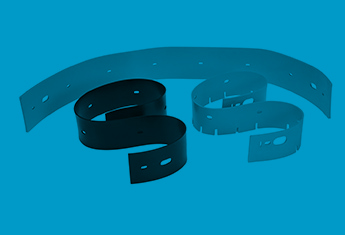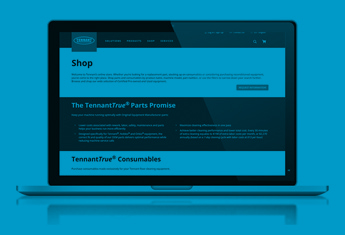Your shopping cart is empty.
Squeegee Blades 101
Posted in Best Practices, Industry News & Trends, Cleaning Challenges,
An overview of floor scrubber squeegees and maintenance best practices

By rotating the squeegee blade, you can clean with all four sides of it – increasing the life of the squeegee.
Squeegee Blade Overview
What is a squeegee? Other than being a funny word, the squeegee is arguably one of the most important components of a floor scrubber. In the simplest terms, a squeegee blade is a piece of rubber, urethane, Linard® or Linatex® that attaches to the back and/or sides of a floor scrubber or sweeper-scrubber and funnels water so the vacuum fan can pick up the liquid as the floor cleaning machine passes over it. The combination of the squeegee assembly, squeegee blades and vacuum fan allows for optimal water pick-up.
The squeegee is a critical component of the machine’s water management system, which leaves floors clean, and even more importantly, dry and safe, which helps to prevent slip-and-fall accidents — one of the most frequent types of worker compensation claims, according to the EHS Daily Advisor.
If your squeegee blades are not properly maintained, your floor scrubber may leave behind streaks, debris or water, resulting in rework and wasted time, which costs you extra money.
EVERY 30 MINUTES OF EXTRA CLEANING = $198 EXTRA LABOR COSTS PER MONTH, OR $2,370 ANNUALLY*
Squeegee Blade Materials
There are multiple materials that floor cleaning squeegees can be made of, such as rubber and urethane, and each material has qualities that make it ideal for certain types of floors or environments.
Gum rubber squeegee blades are the lowest cost, which helps you save money on replacements. These squeegees are slightly stiffer and are recommended for smooth and even indoor floors. Gum rubber is not chemical resistant.
Urethane squeegees are chemical resistant, meaning they are ideal for cleaning organic and petroleum-based oils.
Linatex® is a premium squeegee blade material and comes standard on most Tennant equipment. The proprietary material offers outstanding strength, resilience and resistance for long-lasting performance.
Linatex is ideal for wet applications when paired with a Linard® squeegee for the front blade.

Floor scrubbers have squeegee blades on the back, and sometimes sides, to help funnel water and cleaning solution so the vacuum fan can suck them up as it cleans, leaving your floor clean and dry.

Squeegees are available in a variety of materials to best match the facility’s floor type and environment.
Squeegee Blade Replacement and Maintenance
While squeegees may be one of the most commonly replaced parts on your floor cleaning equipment, there are many things you can do to keep them in optimal condition for as long as possible to cut down on replacement costs.
Rotate squeegees for increased life. By rotating which side of the squeegee is on the floor, you can get longer use out of a single blade. Squeegee wear depends on the material of the squeegee and the type and condition of the floor. Inspect the condition of your squeegee blades daily is, and rotate or replace the blade when it is worn halfway through.
Replace squeegees before they become ineffective. When you begin to see wear and tear on an edge of your squeegee blade, rotate it in a timely manner, and once cleaning on the 4th edge, have a replacement blade ready to go so you’re always cleaning with a highly performing squeegee and not sacrificing cleanliness and safety.
Purchase OEM squeegees for optimal performance. Look-alike or third party squeegees blades are not specifically designed for your cleaning machine and may not provide the quality of cleaning you expect.
While the squeegees blades may look the same, don’t be fooled by lower priced parts – you will spend more in the long run replacing poorly made squeegees than purchasing OEM squeegees.

When a squeegee is worn halfway through, rotate it to a new side to maintain optimal performance.

Ensure there is even pressure across the entire squeegee blade. A properly positioned squeegee has even pressure from tip to tip and is set on the floor at an angle where the inside edge of the squeegee blade is scraping across the floor for optimal water pick-up. If there is too much pressure, the squeegee can get smashed down and will not pick up water properly.
How To Resolve Common Squeegee Issues:
Squeegee is not picking up water in the center. Adjustments to the amount of pressure on the squeegee blade can be made to ensure there is equal distribution across the entire length, which will prevent the center of the blade from being higher than the tips. Review your operator manual to understand how to best adjust the squeegees on your machine.
Squeegee is not picking up water on the edges. Similar to the example above, there may be adjustments that need to be made to ensure the squeegee is dragging across the floor at the correct angle. Review your operator manual to understand how to best adjust the squeegees on your machine.
Streaks are being left on the floor. In this case, it’s likely your squeegee blade has dirt or debris built up on it, which is causing the squeegee to inconsistently drag across the floor. To resolve, raise your squeegee assembly and wipe the length of your squeegees with a clean rag or towel to remove the debris.
By choosing the right squeegee blade for your environment and properly maintaining them, you will save money and time in replacement costs and rework.
*Based on a 7-day cleaning cycle with labor costs at $13 per hour
RELATED LINKS
Ready to take your cleaning to the next level?
Whether you are requesting a product demonstration or a quote, ordering parts, or making a service appointment, you've come to the right place. Tennant professional representatives are ready with answers to your questions, and we look forward to showing you how much we appreciate your business.
*Required Fields




